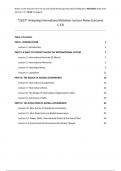Class notes
*2023* Analyzing International Relations Lecture Notes (Lectures 1-13) - GRADE 7,5
- Course
- Institution
Notes on the lectures from the course (2023) Analyzing International Relations. INCLUDES notes from lectures 1-13 (Total: 44 pages).
[Show more]



